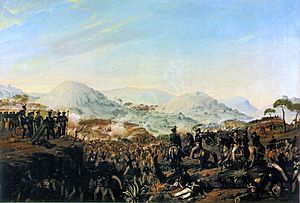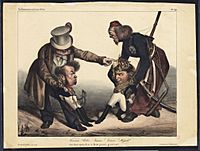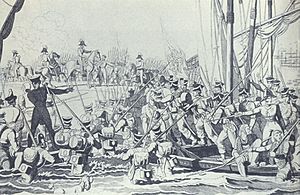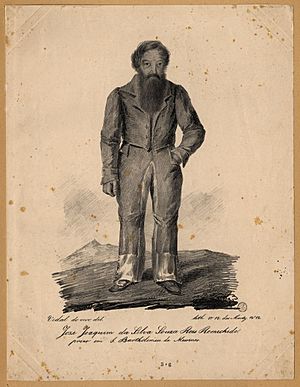Liberal Wars facts for kids
Quick facts for kids Liberal Wars |
|||||||
|---|---|---|---|---|---|---|---|
 Battle of Ferreira Bridge, 23 July 1832 |
|||||||
|
|||||||
| Belligerents | |||||||
Supported by:
|
Supported by: |
||||||
| Commanders and leaders | |||||||
|
|
||||||
The Liberal Wars (also known as the Portuguese Civil War) was a conflict in Portugal from 1828 to 1834. It was a fight between two main groups: the Liberals and the Absolutists.
The Liberals wanted a constitutional monarchy. This meant the king's power would be limited by a constitution and a parliament. The Absolutists wanted an absolute monarchy. This meant the king would have complete power.
The war was also called the War of the Two Brothers because it was fought between two royal brothers, Dom Pedro and Dom Miguel. Many countries got involved, including the United Kingdom, France, and Spain.
Contents
Why the War Started

The war began after King John VI died in 1826. His oldest son, Dom Pedro, was also the Emperor of Brazil. Some people argued that Pedro lost his right to the Portuguese throne when Brazil became independent.
Pedro briefly became King Pedro IV of Portugal. However, people in both Portugal and Brazil did not want one ruler for both countries. So, Pedro gave up the Portuguese throne. He chose his young daughter, Maria, who was only 7 years old, to be the next queen.
In April 1826, Pedro created a new set of rules for Portugal called the Constitutional Charter. He left the throne to Maria, and his sister Isabel Maria became the regent. A regent rules in place of a child king or queen.
Portugal's New Rules
Pedro's new rules tried to make both the Absolutists and Liberals happy. It set up four parts of government. The law-making part, called the Legislature, had two groups.
One group, the Chamber of Peers, had members chosen by the king for life. The other group, the Chamber of Deputies, had 111 members. These members were elected by local groups, who were chosen by men who owned property and paid taxes. The king still had a lot of power, including the right to stop any new laws.
Growing Unhappiness
The Absolutists, who were mostly landowners and the Church, were not happy with these new rules. They believed Miguel was the true king. They thought Pedro had lost his right to the Portuguese crown when he became emperor of Brazil.
They were also worried about liberal changes happening in other countries. In February 1828, Miguel returned to Portugal. His supporters quickly declared him king. Miguel then got rid of the new government groups and called for the old-style parliament to make him absolute ruler. This parliament agreed, making Miguel king and canceling Pedro's new rules.
The Fight Begins

The Liberals did not accept Miguel as king. On May 18, the army in Porto, a city known for its progressive ideas, declared loyalty to Pedro and his daughter Maria. Other cities joined the rebellion. Miguel fought back, and many Liberals were arrested or fled to Spain and Britain. This led to five years of harsh rule by Miguel.
Meanwhile, Pedro gave up his title as Emperor of Brazil in 1831. He sailed to Britain and then to the Azores islands, which were controlled by Liberals. There, he set up a government that was against Miguel. Miguel's forces tried to block the islands, but French ships attacked them.
In July 1832, with help from Liberals in Spain and England, Pedro's forces landed near Porto. The Miguelites left Porto, and Pedro's army was then surrounded by Miguel's forces for almost a year.
In June 1833, the Liberals, still stuck in Porto, sent a force south to the Algarve region. This force, led by the Duke of Terceira, captured Lisbon on July 24. At the same time, a Liberal naval fleet led by Charles Napier defeated Miguel's fleet near Cape Saint Vincent.
The Liberals now held Lisbon. Pedro moved there from Porto. Maria was declared queen, and Pedro became regent. He took property from those who supported Miguel. He also closed religious houses and took their property, which caused problems with the Catholic Church.
The Absolutists, supported by the rich landowners and the Church, controlled the countryside. The Liberals held the big cities like Lisbon and Porto, where they had many supporters among the middle class. Fighting continued into 1834. In the south, a famous guerrilla leader named Remexido continued to fight for Miguel.
Peace at Last
The Battle of Asseiceira on May 16, 1834, was the final big battle. Miguel's army was still large, but on May 26, 1834, a peace agreement was signed at Evoramonte.
To stop the fighting, Miguel officially gave up his claim to the throne of Portugal. He was given a yearly payment and sent away from the country. Pedro brought back the Constitutional Charter, but he died soon after, on September 24, 1834.
Maria da Glória then became Queen Maria II of Portugal, continuing her reign.
See also
 In Spanish: Guerras liberales para niños
In Spanish: Guerras liberales para niños
- Liberalism in Portugal
- Dissolution of the monasteries in Portugal
- Joaquim António de Aguiar
- Remexido
- First Carlist War




